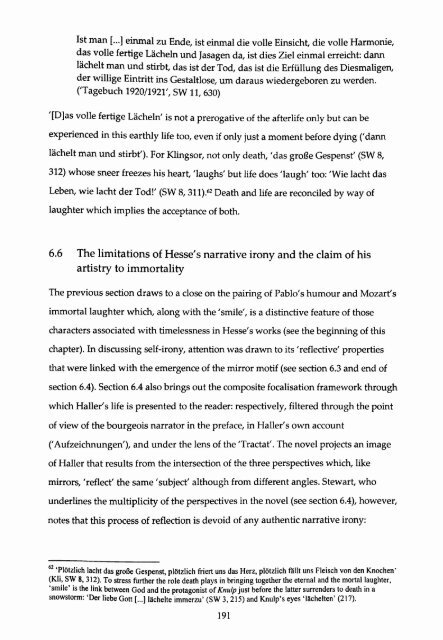HERMANN HESSE AND THE DIALECTICS OF TIME Salvatore C. P. ...
HERMANN HESSE AND THE DIALECTICS OF TIME Salvatore C. P. ...
HERMANN HESSE AND THE DIALECTICS OF TIME Salvatore C. P. ...
Create successful ePaper yourself
Turn your PDF publications into a flip-book with our unique Google optimized e-Paper software.
1st man [...] einmal zu Ende, ist einmal die voile Einsicht, die voile Harmonic,<br />
das voile fertige Lacheln und Jasagen da, ist dies Ziel einmal erreicht: dann<br />
lachelt man und stirbt, das ist der Tod, das ist die Erfullung des Diesmaligen,<br />
der willige Eintritt ins Gestaltlose, um daraus wiedergeboren zu werden.<br />
('Tagebuch 1920/1921', SW 11, 630)<br />
'[D]as voile fertige Lacheln' is not a prerogative of the afterlife only but can be<br />
experienced in this earthly life too, even if only just a moment before dying ('dann<br />
lachelt man und stirbt'). For Klingsor, not only death, 'das grofie Gespenst' (SW 8,<br />
312) whose sneer freezes his heart, 'laughs' but life does 'laugh' too: 'Wie lacht das<br />
Leben, wie lacht der Tod!' (SW 8, 311).62 Death and life are reconciled by way of<br />
laughter which implies the acceptance of both.<br />
6.6 The limitations of Hesse's narrative irony and the claim of his<br />
artistry to immortality<br />
The previous section draws to a close on the pairing of Pablo's humour and Mozart's<br />
immortal laughter which, along with the 'smile', is a distinctive feature of those<br />
characters associated with timelessness in Hesse's works (see the beginning of this<br />
chapter). In discussing self-irony, attention was drawn to its 'reflective' properties<br />
that were linked with the emergence of the mirror motif (see section 6.3 and end of<br />
section 6.4). Section 6.4 also brings out the composite focalisation framework through<br />
which Haller's life is presented to the reader: respectively, filtered through the point<br />
of view of the bourgeois narrator in the preface, in Haller's own account<br />
('Aufzeichnungen'), and under the lens of the Tractat'. The novel projects an image<br />
of Haller that results from the intersection of the three perspectives which, like<br />
mirrors, 'reflect' the same 'subject' although from different angles. Stewart, who<br />
underlines the multiplicity of the perspectives in the novel (see section 6.4), however,<br />
notes that this process of reflection is devoid of any authentic narrative irony:<br />
62 'Plotzlich lacht das groBe Gespenst, plotzlich friert uns das Herz, plotzlich fallt uns Fleisch von den Knochen'<br />
(Kli, SW 8, 312). To stress further the role death plays in bringing together the eternal and the mortal laughter,<br />
'smile' is the link between God and the protagonist of Knulp just before the latter surrenders to death in a<br />
snowstorm: 'Der liebe Gott [...] lachelte immerzu' (SW 3, 215) and Knulp's eyes Machelten' (217).<br />
191
















